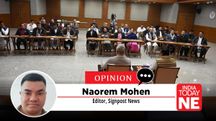Why citizens and military must join forces in evolving warfare
The future of warfare transcends traditional battlefields, demanding unprecedented coordination between civilians and military. Can India’s fragmented systems evolve into a unified force to safeguard national security?

The nature of warfare has been changing over the years driven by the dynamic geostrategic landscape and technological developements. The recent conflicts around the world have proven that any future warfare will be multidimensional embroiling the complete nation. The battles will be fought in land, air and sea by the Armed Forces; but will also include other domains like Cyber Warfare, Information warfare, Economic Warfare etc. The Ukraine conflict as well as the Middle East conflagration has amply brought out the importance of employment of all instruments of power in war winning efforts. The civilian population including women and children have also been increasingly impacted by wars. How prepared is India as a nation, faced with traditional as well as non-traditional threats, in meeting any such future conflicts?
A nation prepares for war during peacetime which include training, organising and equipping the Armed Forces to meet any emerging threats, building up logistics and war sustenance, capability developments including infrastructure and niche technology. Approach to war fighting includes evolution of National Security Strategy and establishment of Higher Defence Organisations mandated for decision making, strategizing and evolving plans which are then prosecuted by the Armed Forces on ground. Though the National Security Strategy is still to be enunciated, India has a functional Higher Defence Organisation and policy documents specifying roles of all stakeholders in case of war.The Kargil Review Committee Report of 1999 had recommended review of the national security architecture and apex decision making, some of which have been implemented to improve response to threats.However, the changing nature of warfare and its possible impact necessitates upgradation of structures and proceduresboth during war and peace. Theaterisation and integration of all three services of Armed Forces, Creation of Cyber and Space Command are likely to bring about the desired review and refinement of India’s response during war. But the national structures and procedures in place during preparatory phase of war or during the peacetime need major review.
The whole of nation approach to warfighting aimed at mitigating threat to the nation’s territorial integrity need to aggregate all instruments of power for synergized application of the Nation’s might. In this context it is important to review the concept of Civil Military Fusion which must be one of the drivers of the national efforts. Conventionally, civil military fusion in India is understood as coordination mechanism between the Armed Forces and the Government and other agencies while dealing with law and order situation or while dealing with natural calamities or as a forum for resolution of issues/disputes between the state and Armed Forces. The forum of Civil Military Liaison Conferences has traditionally been used by each state with the local Armed Forces representatives to resolve issues of mutual interest. In insurgency affected states of Jammu and Kashmir and North East, several coordination mechanisms have evolved over the years which have facilitated conduct of operations in a synergized manner. These structures and their mandates evolved based on experiences and lessons learnt over the years. The Unified Headquarters, Joint Intelligence sharing mechanisms etc. have matured over the years and have yielded the desired results albeit with dissonance at times.
In addition to the reforms in Armed Forces to bring about jointness and integration, there has been numerous initiatives at national level to ensure optimum utilisation of the finite resources. Niti Aayog, PM Gatishakti, new National Logistics policy have ensured alignment of priorities in nation building and includes the military requirements as well. For the North East which share active border with neighbouring countries like China, Myanmar and Bangladesh, creation of Ministry of DoNER and North East Council have taken care of focused development of the region, but misses out on inputs from the Armed Forces, which is an important stakeholder in the remote border areas, since there is no representation from the Armed Forces at the Council.
There are numerous areas which require civil military fusion as driver. Given the internal threats and secessionist movements that the country has seen, particularly in remote border areas where Armed Forces are still considered as face of governance, promotion of national integration would be first such area. Drawing a comprehensive national security architecture against both internal and external threat is the next key area which need a relook. Infrastructure development particularly in border areas need synergized efforts of State, Centre, Local population and the Armed Forces. These would include development of dual use technology and infrastructures in fields of operational logistics, border infrastructure like strategic roads, telecommunication, aviation assets etc. For capability development and enhancement of operational preparedness efforts are required to enhance the Intelligence, Surveillance and Reconnaissance capabilities, Communication and navigation technology and development of drones and Unarmed Aerial Vehicle. Development of niche technology in fields like autonomous weapons, Artificial Intelligence enabled Logistics, robotics, disruptive technology and Decision Support systems will need a whole of government approach. Prosecution of Information warfare to win the perception battle or the battle of narratives also need complete civil military fusion. Cyber warfare domain also needs focused development of capabilities to prosecute offensive as well as defensive cyber operations. Promotion of digital India and adventure tourism in remote areas need participation of both state and the Military. These are just some of the areas requiring coherence in thoughts and execution between Civilian and Military stakeholders, there are many such important areas which need integrated efforts. Revamping the existing organisations by making them more inclusive and responsive to needs would be the first step to kickstart the whole of nation approach to mitigate the present and future threats of the nation. Enhancing the role and mandate of such organisations to include the focus areas discussed previously would be the next step towards achieving complete Civil Military Fusion.
Copyright©2025 Living Media India Limited. For reprint rights: Syndications Today









